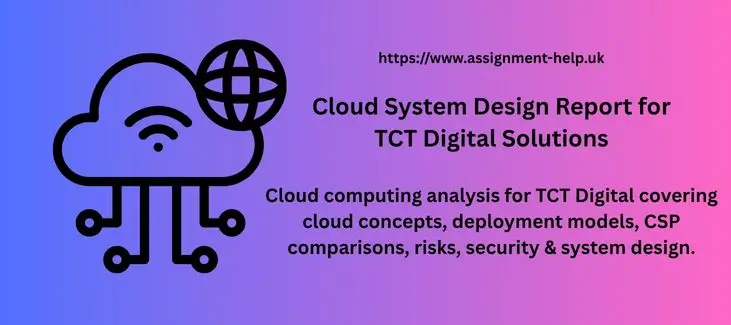
Contents
- 1 Cloud System Design Report for TCT Digital Solutions
- 1.1 Expert Answers on Above Cloud Computing Questions
- 1.1.1 Evolution and fundamental concepts of cloud computing
- 1.1.2 Why organisations should migrate to cloud
- 1.1.3 Appropriate deployment model for TCTDS
- 1.1.4 Deployment models with examples
- 1.1.5 Cloud service models and selection for TCTDS
- 1.1.6 Simple deployment model
- 1.1.7 Justification of selected tools
- 1.1.8 Do You Need Full Answer With References?
- 1.1 Expert Answers on Above Cloud Computing Questions
Cloud System Design Report for TCT Digital Solutions
Vocational Scenario
You have been employed as a junior cloud systems specialist for Vulcan Cloud Solutions Limited (VCS). VCS provides cloud-based design and consultancy services to a range of clients from multiple industry sectors. The services offered by VCS include:
- providing an audit of an organisation’s infrastructure looking at a possible move to a cloud-based service
- reviewing and recommending improvements to an organisation’s existing cloud provision
- advice on implementing cloud-based solutions
- advice on migrating existing systems to cloud-based solutions.
VCS has received an enquiry from a new client and your project manager has decided that this would be ideal for you to handle by yourself as your first solo project.
The client is TCT Digital Solutions Ltd. (TCTDS), a very small software engineering start-up company. The company was founded in 2018 by two friends, the chief executive officer (CEO) and the technical architect, providing bespoke services to the publishing industry.
Such services include:
- converting physical books to eBooks
- copy-editing and proofreading services
- graphics production and image editing services
- document metadata design and tagging.
TCTDS hired its first employee in 2019 and now has a small team of developers and staff members working out of a single office. The business is looking to expand rapidly and has taken the decision to not expand the physical premises but to hire people willing to work remotely.
The business works out of an office that has been partitioned with temporary screens into three areas. There is a development area for the development team, an administrator area for the office administrators and a server area that hosts the company servers. Currently all staff data, both personal and for payroll, is kept on dedicated human resource (HR) servers in the server area.
All TCTDS common data files are currently located on a shared public access file server. This contains all resources created by developers and administrators, as well as areas for each staff member to store their own data files.
TCTDS maintains its own email exchange server, holding all staff and administrator emails as well as historical emails from all previous years. In addition, Office and other development specific software was either installed on each machine or linked from a central application server.
The CEO had initially opened and operated the business on a very restricted budget and reasoned that, as the business was a low security risk, data backups could be performed on a single 2 X 8TB RAID (redundant array of inexpensive disks) direct attached storage (DAS) drive, with data backups being carried out within the internal RAID drive array.
The email server, file server, application server, backup DAS drive and network domain server are in a non-secured area within the main office, located on their own network segment.
The business had previously started to develop a shared intranet that provided a web interface to the file server and a way for developers to access business data. In looking at the success of this for the existing business, and because of the imminent rapid expansion using developers working exclusively from home, the client wants you to review the current infrastructure and services provided by TCTDS and look to moving to a cloud-based service. TCTDS has the following requirements.
- The client is not sure what ‘the cloud’ is and needs help in understanding this concept.
- The client needs to understand the range of cloud providers available, what services they offer and how this could benefit TCTDS.
- The cloud system must duplicate the current hardware and software infrastructure (see Annexe A – Infrastructure documents).
- Due to data protection concerns, the HR data cannot be located on a cloud server and needs to be stored on site.
- The HR data must be accessible from any cloud software.
- All data must be backed up to the cloud.
- The cloud system must provide guaranteed levels of network security so that a loss of data can never happen.
- TCTDS wants all staff to be able to access public file data from any location and from any device, with appropriate authentication and authorisation in place.
- TCTDS wants the ability to customise any application to streamline and improve the workplace experience for its staff.
- TCTDS wants to know how much of this is actually feasible. You have been given the current infrastructure requirements from TCTDS in Appendix A – Infrastructure documents). Make sure you study them before attempting this assignment.
As part of your work for VCS, your CEO wants you to put together a presentation on cloud services that you will present to the client as well as four senior VCS cloud systems analysts, so that you can demonstrate you have the breadth of knowledge required to begin to work with larger clients on your own.
Assignment Activity And Guidance
You will produce a report that will explain the purpose, benefits and limitations of cloud computing to a non-technical audience. Your report should include:
- an analyse of the evolution and fundamental concepts of cloud computing. (P1)
- Discussion of why an organization should migrate to a cloud computing solution. (M1)
You will review the requirements of TCTDS and produce a report on a cloud-based system design that meets the company’s needs. Your report should go on to design a deployment model for the new TCTDS system to be hosted in the cloud, including:
- a demonstration of deployment models with real-world examples. (M2)
- a definition of appropriate deployment model for TCTDS. (P3)
- a comparison of the cloud service models and choose the appropriate models for TCTDS. (P4)
You will review the requirements of TCTDS and produce a report on a cloud-based system design that meets the company’s needs. Your report should include:
- a design for a simple deployment model to include the service models and technologies of cloud computing for TCTDS. (P2)
- a review of how different deployment models, service models and technologies will work together in the design for TCTDS. (P2)
- a justification of the tools chosen to realise a cloud computing solution. (D1)
Finally, when considering the recommended design. You should also produce a report summarises and explains how different CSPs offer alternative approaches to providing a cloud architecture for TCTDS. Your research notes should include:
- a comparison of the services offered by a range of CSPs. (P5)
- an explanation of the frameworks and tools offered by CSPs. (P5)
- Implementation and configuration a cloud computing platform with selected CSP. (P5, P6).
- a discussion of the issues and constraints that can be faced during the development process. (M3)
- a critical discussion of strategies and methods to surmount challenges and limitations encountered throughout the developmental process. (D2)
- an analysis of the problems and technical challenges that arise in a cloud computing platform and discussion of appropriate solutions. (P7)
- an assessment of the most risks in moving IT systems to the cloud solution. (P8)
- a discussion of how to overcome security issues when building a secure cloud platform. (M4)
- a critical discussion of how the organisation should protect its data when migrating to a cloud solution. (D3)
Expert Answers on Above Cloud Computing Questions
Evolution and fundamental concepts of cloud computing
The evolution of cloud computing can be tracked to virtualization, grid computing, utility computing and web based services. The key concepts include broad network access, on demand self service, resource pooling, rapid elasticity etc. The main focus of modern cloud systems is on scalability, and remote accessibility.
Why organisations should migrate to cloud
There are many benefits available such as reduction in the hardware and maintenance cost, better support for remote working, improvement in scalability, better backup leading to business continuity, and it also enhances security and compliance.
Appropriate deployment model for TCTDS
The most appropriate model is the hybrid cloud because it allows for hR data to remain on premises, balances security and scalability and it is also effective in moving the shared data to the public cloud.
Deployment models with examples
Public cloud such as AWS, Azure utilised by Netflix and spotify. Private cloud by government agencies and banks using VMware/OpenStack, and hybrid cloud utilised by companies responsible for balancing sensitive and non-sensitive data.
Cloud service models and selection for TCTDS
The Cloud Service models available are IaaS, PaaS and Saas whereby IaaS is good for cloud storage, networking and PaaS is for development environment and SaaS is for emails and collaboration tools. FPr TCTDS, it is recommended to use the combination of IaaS and Saas and PaaS.
Simple deployment model
The deployment should be carried out as follows:
The email server should be moved to SaaS and file server to IaaS and application server to PaaS. The remote access can be possible through secure authentication and HR data needs to stay on premises.
Justification of selected tools
Azure active directory is good for secured identity management and Azure blob storage for cost effective file storage. Microsoft 365 SaaS is for achieving security and reliability in email, and API gateway is for secure connection to HR servers.
| Disclaimer: This answer is a model for study and reference purposes only. Use it for your learning to do your assignment on your own. Please do not submit it as your own work. |
Do You Need Full Answer With References?
Cloud Computing assignments are technical and require a good understanding of different cloud concepts including deployment models, service models, rich and security management and many more. If you are struggling with writing your Cloud Computing assignment, you can consider taking professionals’ help today. Get help in completing your assignment by consulting our top Cloud Computing experts.




